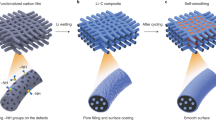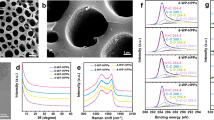Abstract
The lithium–O2 ‘semi-fuel’ cell based on the reversible reaction of Li and O2 to form Li2O2 can theoretically provide energy densities that exceed those of Li-ion cells by up to a factor of five. A key limitation that differentiates it from other lithium batteries is that it requires effective catalysts (or ‘promoters’) to enable oxygen reduction and evolution. Here, we report the synthesis of a novel metallic mesoporous oxide using surfactant templating that shows promising catalytic activity and results in a cathode with a high reversible capacity of 10,000 mAh g−1 (∼1,000 mAh g−1 with respect to the total electrode weight including the peroxide product). This oxide also has a lower charge potential for oxygen evolution from Li2O2 than pure carbon. The properties are explained by the high fraction of surface defect active sites in the metallic oxide, and its unique morphology and variable oxygen stoichiometry. This strategy for creating porous metallic oxides may pave the way to new cathode architectures for the Li–O2 cell.
This is a preview of subscription content, access via your institution
Access options
Subscribe to this journal
Receive 12 print issues and online access
$259.00 per year
only $21.58 per issue
Buy this article
- Purchase on Springer Link
- Instant access to full article PDF
Prices may be subject to local taxes which are calculated during checkout




Similar content being viewed by others
References
Aricò, A. S., Bruce, P. G., Scrosati, B., Tarascon, J-M. & Schalkwijk, W. V. Nanostructured materials for advanced energy conversion and storage devices. Nature Mater. 4, 366–377 (2005).
Read, J. et al. Oxygen transport properties of organic electrolytes and performance of lithium/oxygen battery. J. Electrochem. Soc. 150, A1351–A1356 (2003).
Débart, A., Paterson, A. J., Bao, J. & Bruce, P. G. α-MnO2 nanowires: a catalyst for the O2 electrode in rechargeable lithium batteries. Angew. Chem. Int. Ed. 47, 4521–4524 (2008).
Laoire, C. O., Mukerjee, S. & Abraham, K. M. Elucidating the mechanism of oxygen reduction for lithium–air battery application. J. Phys. Chem. C 113, 20127–20134 (2009).
Lu, Y-C., Gasteiger, H. A., Parent, M. C., Chiloyan, V. & Shao-Horn, Y. The influence of catalysts on discharge and charge voltages of rechargeable Li–oxygen batteries. Electrochem. Solid State Lett. 13, A69–A72 (2010).
Zhang, J., Xu, W., Li, X. & Liu, W. Air dehydration membrane for nonaqueous lithium–air batteries. J. Electrochem. Soc. 157, A940–A946 (2010).
Trahey, L. et al. Activated lithium-metal-oxides as catalytic electrodes for Li–O2 cells. Electrochem. Solid State Lett. 14, A64–A66 (2011).
Lee, J-S. et al. Metal–air batteries with high energy density: Li–air versus Zn–air. Adv. Energy Mater. 1, 34–50 (2011).
Abraham, K. M. & Jiang, Z. A polymer electrolyte-based rechargeable lithium/oxygen battery. J. Electrochem. Soc. 143, 1–5 (1996).
Ogasawara, T., Débart, A., Holzapfel, M., Novák, P. & Bruce, P. G. Rechargeable Li2O2 electrode for lithium batteries. J. Am. Chem. Soc. 128, 1390–1393 (2006).
McCloskey, B. D., Bethune, D. S., Shelby, R. M., Girishkumar, G. & Luntz, A. C. Solvents’ critical role in nonaqueous lithium–oxygen battery electrochemistry. J. Phys. Chem. Lett. 2, 1161–1166 (2011).
Beattie, S. D., Manolescu, D. M. & Blair, S. L. High-capacity lithium–air cathodes. J. Electrochem. Soc. 156, A44–A47 (2009).
Girishkumar, G., McCloskey, B., Luntz, A. C., Swanson, S. & Wilcke, W. Lithium–air battery: promise and challenges. J. Phys. Chem. Lett. 1, 2193–2203 (2010).
Laoire, C. O., Mukerjee, S., Plichta, E. J., Hendrickson, M. A. & Abraham, K. M. Rechargeable lithium/TEGDME–LiPF6/O2 battery. J. Electrochem. Soc. 158, A302–A308 (2011).
McCloskey, B. D. et al. Twin problems of interfacial carbonate formation in nonaqueous Li–O2 batteries. J. Phys. Chem. Lett. 3, 997–1001 (2012).
McCloskey, B. D. et al. On the efficacy of electrocatalysis in nonaqueous Li–O2 batteries. J. Am. Chem. Soc. 133, 18038–18041 (2011).
Lu, Y-C. et al. Platinum–gold nanoparticles: a highly active bifunctional electrocatalyst for rechargeable lithium–air batteries. J. Am. Chem. Soc. 132, 12170–12171 (2010).
Laoire, C. O., Mukerjee, S. & Abraham, K. M. Influence of nonaqueous solvents on the electrochemistry of oxygen in the rechargeable lithium–air battery. J. Phys. Chem. C 114, 9178–9186 (2010).
Mizuno, F., Nakanishi, S., Kotani, Y., Yokoishi, S. & Iba, H. Rechargeable Li–air batteries with carbonate-based liquid electrolytes. Electrochemistry 78, 403–405 (2010).
Freunberger, S. A. et al. Reactions in the rechargeable lithium–O2 battery with alkyl carbonate electrolytes. J. Am. Chem. Soc. 133, 8040–8047 (2011).
Suntivich J. et al. Design principles for oxygen-reduction activity on perovskite oxide catalysts for fuel cells and metal–air batteries. Nature Chem. 3, 546–550 (2011).
Neburchilov, V., Wang, H., Martin, J. J. & Qu, W. A review on air cathodes for zinc–air fuel cells. J. Power Sources 195, 1271–1291 (2010).
Horowitz, H. S., Longo, J. M. & Horowitz, H. H. Oxygen electrocatalysis on some oxide pyrochlores. J. Electrochem. Soc. 130, 1851–1859 (1983).
Goodenough, J. B., Manoharan, R. & Paranthaman, M. Surface protonation and electrochemical activity of oxides in aqueous solution. J. Am. Chem. Soc. 112, 2076–2082 (1990).
Takeda, T., Kanno, R., Kawamoto, Y., Takeda, Y. & Yamamoto, O. New cathode materials for solid oxide fuel cells ruthenium pyrochlores and perovskites. J. Electrochem. Soc. 147, 1730–1733 (2000).
Subramanian, M. A., Aravamudan, G. & Subba Rao, G. V. Oxide pyrochlores— a review. Prog. Solid State Chem. 15, 55–143 (1983).
Akazawa, T., Inaguma, Y., Katsumata, T., Hiraki, K. & Takahashi, T. Flux growth and physical properties of pyrochlore Pb2Ru2O6.5 single crystals. J. Cryst. Growth 271, 445–449 (2004).
Cheng, F. et al. Rapid room-temperature synthesis of nanocrystalline spinels as oxygen reduction and evolution electrocatalysts. Nature Chem. 3, 79–84 (2010).
Lai, X. et al. Ordered mesoporous copper oxide with crystalline walls. Angew. Chem. Int. Ed. 46, 738–741 (2007).
Jiao, F. & Bruce, P. G. Mesoporous crystalline β-MnO2—a reversible positive electrode for rechargeable lithium batteries. Adv. Mater. 19, 657–660 (2007).
Shi, Y. et al. Ordered mesoporous metallic MoO2 materials with highly reversible lithium storage capacity. Nano Lett. 9, 4215–4220 (2009).
Boissière, C., Grosso, D. & Prouzet, E. in Nanomaterials: Inorganic and Bioinorganic Perspectives (eds Lukehart, C. M. & Scott, R. A.) 381–397 (Wiley, 2008).
Bagshaw, S. A., Prouzet, E. & Pinnavaia, T. J. Templating of mesoporous molecular sieves by nonionic polyethylene oxide surfactants. Science 269, 1242–1244 (1995).
Horowitz, H. S., Longo, J. M. & Lewandowski, J. T. New oxide pyrochlores: A2[B2–xAx]O7–y (A = Pb, Bi; B = Ru, Ir). Mater. Res. Bull. 16, 489–496 (1981).
Beyerlein, R. A., Horowitz, H. S. & Longo, J. M. The electrical properties of A2[Ru2–xAx]O7–y (A = Pb or Bi) pyrochlores as a function of composition and temperature. J. Solid State Chem. 72, 2–13 (1988).
Zhao, D. et al. Triblock copolymer synthesis of mesoporous silica with periodic 50 to 300 ångstrom pores. Science 279, 548–552 (1988).
Mitchell, R. R., Gallant, B. M., Thompson, C. V. & Shao-Horn, Y. All-carbon-nanofiber electrodes for high-energy rechargeable Li–O2 batteries. Energy Environ. Sci. 4, 2952–2958 (2011).
Lu, Y-C. et al. The discharge rate capability of rechargeable Li–O2 batteries. Energy Environ. Sci. 4, 2999–3007 (2011).
Bryantsev, V. S. et al. Predicting solvent stability in aprotic electrolyte Li–air batteries: nucleophilic substitution by the superoxide anion radical (O2•−). J. Phys. Chem. A 115, 12399–12409 (2011).
Yeager, E. Dioxygen electrocatalysis: mechanism in relation to catalyst structure. J. Mol. Catal. 38, 5–25 (1986).
Lu, Y-C. et al. Electrocatalytic activity studies of select metal surfaces and implications in Li–air batteries. J. Electrochem. Soc. 157, A1016–A1025 (2010).
Freunberger, S. A. et al. The lithium–oxygen battery with ether-based electrolytes. Angew. Chem. Int. Ed. 50, 8609–8613 (2011).
Mizuno, F. et al. Design of non-aqueous liquid electrolytes for rechargeable Li–O2 batteries. Electrochemistry 79, 876–881 (2011).
Zhang, Z. et al. Increased stability toward oxygen reduction products for lithium–air batteries with oligoether-functionalized silane electrolytes. J. Phys. Chem. C 115, 25535–25542 (2011).
Black, R. et al. Screening for superoxide reactivity in Li–O2 batteries. J. Am. Chem. Soc. 134, 2902–2905 (2012).
Tarascon, J-M., Gozdz, A. S., Schmutz, C., Shokoohi, F. & Warren, P. C. Performance of Bellcore's plastic rechargeable Li-ion batteries. Solid State Ionics 86–88, 49–54 (1996).
Amatucci, G. G., Tarascon, J-M. & Klein, L. C. CoO2: the end member of the LixCoO2 solid solution. J. Electrochem. Soc. 143, 1114–1123 (1996).
Acknowledgements
The authors acknowledge the Natural Sciences and Engineering Council of Canada for support through its Strategic, Discovery, and Canada Research Chair programmes.
Author information
Authors and Affiliations
Contributions
S.H.O. and L.F.N. developed the concept and designed the experiments. S.H.O. carried out the experimental work. R.B. and E.P. helped with the design and experiments, as well as the SEM imaging. J.H.L. contributed to some experiments involving characterization and electrochemistry.
Corresponding author
Ethics declarations
Competing interests
The authors declare no competing financial interests.
Supplementary information
Supplementary information
Supplementary information (PDF 18550 kb)
Rights and permissions
About this article
Cite this article
Oh, S., Black, R., Pomerantseva, E. et al. Synthesis of a metallic mesoporous pyrochlore as a catalyst for lithium–O2 batteries. Nature Chem 4, 1004–1010 (2012). https://doi.org/10.1038/nchem.1499
Received:
Accepted:
Published:
Issue Date:
DOI: https://doi.org/10.1038/nchem.1499
This article is cited by
-
Emergence of high piezoelectricity from competing local polar order-disorder in relaxor ferroelectrics
Nature Communications (2023)
-
Carbon-Doped Copper (hydro)Oxides on Copper Wires as Self-supported Bifunctional Catalytic Electrode for Full Water Splitting
Catalysis Letters (2023)
-
C60 as a metal-free catalyst for lithium-oxygen batteries
Nano Research (2023)
-
Coupling interface constructions of hollow Co-Mo mixed multiple oxidation states heterostructure for high-performance aprotic Li-O2 battery
Nano Research (2023)
-
Electrospun Flexible Nanofibres for Batteries: Design and Application
Electrochemical Energy Reviews (2023)



